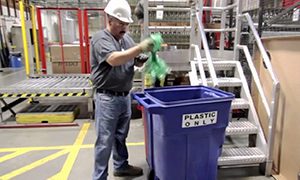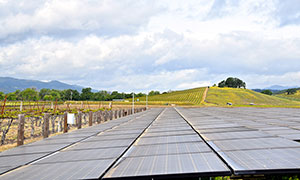When it comes to being #napagreen, the Napa Valley Vintners (NVV) is as committed as our members to reducing our impacts. Here are some of the steps we’re taking to walk the walk.
The NVV headquarters across from the St. Helena library opened in 2010. What the casual observer may not realize is the level of conservation and commitment to efficiency the building represents. These efforts were recognized when we achieved LEED certification for our building. Many of our conservation measures just look like creative design, but they also contribute to our commitment to being green:
In addition to the conservation practices employed during the remodel of our offices, we promote and maintain a culture of resource conservation each and every day. We were one of the first ten companies in the Napa Valley to be certified a “Green Business” by the California Green Business Program. We have to renew this certification every three years which requires verifying that we are committed to a higher standard of preserving our environment each year, including:
Going beyond the Green Business requirements, we have identified four indicators to track our resource conservation efforts: water, paper and electricity usage as well as the percentage of waste we divert from the landfill to go instead to recycling, composting or yard waste.
We chose water, electricity and landfill diversion for the obvious reasons that they are finite commodities, and we chose paper usage because it is coupled with the hidden expenditures of other resources, like toner, gasoline/CO2 output for delivery trucks and chemicals used in the production of paper.
We’ve been tracking these indicators since 2011 and we have improved every year. In 2014, all of our indicators for resource usage came down significantly from 2013.
| Resource | 2011 | 2012 | 2013 | 2014 |
|---|---|---|---|---|
| Paper in cases | 118 | 43 | 39 | 30 |
| % change | -63.6% | -9.3% | -23.1% | |
| Electricity in kWh | 40,800 | 35,040 | 36,085 | 31,877 |
| % change | -14.1% | 3.0% | -11.7% | |
| Water units (1 unit = 784 gallons) | 494 | 622 | 739 | 534 |
| % change | 25.9% | 18.8% | -27.7% | |
| % of our garbage that goes into the landfill | 60 | 40 | 11 | 10 |
| % change | -33.3% | -72.5% | -9.1% |
Half of our staff live in Napa and commute daily to St. Helena. Recently, the Napa County Transportation and Planning Agency released the findings related to transportation behavior in Napa County. All this traffic? It’s not the tourists... it’s people like us who live and work here!
While we’ve always encouraged our staff to carpool or use alternative transportation, we knew that we needed to do more to help our team reduce the number of cars on our roads. Employees are asked to find an alternate way to come to work other than a single individual in a car as often as possible. One day a month is mandatory, but many on our staff make this change weekly. To support our staff, we subsidize public transportation and carpooling costs and recognize the effort internally, which has led to a bigger shift in travel behavior.

Trinchero Family Estates has made waste reduction part of their company-wide DNA.

Cakebread Cellars is championing water conservation with their new green parking lot.
 Saving Energy With Solar
Saving Energy With SolarA PG&E energy audit launched a decade of energy conservation practices at Honig Vineyard & Winery.